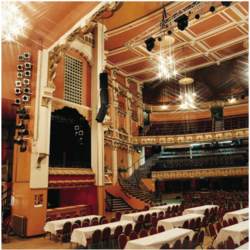Raising the standards of warm-air heating

Draughts in a swimming pool, even warm draughts, will be uncomfortable — making low-velocity warm-air heating essential.
Modern, well insulated large-space buildings require lower heat inputs to their warm air heating systems — but heat distribution must cover much wider areas. ERIC FENTON explains how this can be achieved without extensive ductwork.Modern building design, where effective insulation and carbon reduction measures are imperative, places unprecedented demands on heating systems to perform very efficiently with low heat inputs. While this results in generally lower energy consumption and running costs, it poses the problem of how to distribute heat evenly to the building without distribution losses or additional electricity charges for mechanical delivery to all parts of the building. Traditionally, galvanised-steel ductwork has been used — but in the context of modern building design, ducting may no longer be the best solution. There are two key reasons why ductwork may not be suitable — aesthetics or cost. Ducting can mar the appearance of a building’s interior and can be obtrusive in areas where visual appeal is important. At the same time, galvanised ductwork can be expensive, particularly since the price of steel has risen dramatically in recent years. Another approach is a central air diffusion plenum to provide perfectly homogenous distribution of heat without the heat losses normally associated with extensive ductwork. At the same time, the plenum box delivers warmth without perceptible air movement and creates a comfortable, draught-free environment.

The former royal box of the Olympia Theatre in Liverpool houses the nozzles for the warm-air heating system that can deliver air at a rate of 72 000 m3/h to provide a comfortable environment with no cold spots.
Plenum boxes, such as Reznor’s Novojet system, have a number of rubber nozzles which have a high air induction capability that can rapidly heat or cool large open space buildings. Warm air is supplied to each distribution plenum from a heater positioned at high level inside the building or outside. A modulating burner is essential to achieving comfort temperatures, since fine control of the burner will ensure supply-air temperatures accurately match the requirements of the building and its occupants, while maintaining the lowest possible energy input at all times. Each plenum has multiple distribution nozzles, and each nozzle may be manually adjusted for precise direction of air flow to maintain even distribution of warmth. Air is discharged from the nozzles at high speed, creating a negative pressure zone, thereby inducing the surrounding air. A large amount of secondary air is induced at each nozzle to create a large air mass moving at relatively low velocity. It is this mass of warm air that is distributed around the building, up to 70 m from the plenum. When such a long reach can be achieved from a single point, distribution ductwork becomes redundant. Plenum systems can be used in buildings up to 30 m roof height without requiring any additional high-level destratification or recirculation fans. Inducing air at the plenum effectively eliminates heat stratification and vertical temperature gradients, since warm air is circulating gently all the time. Building occupants remain comfortable, but are unaware of any air movement or draughts. Unlike conventional ducted systems, plenum boxes are ideal for applications requiring both heating and cooling. If a standard means of air distribution is switched over from heating mode to cooling mode, people in the building are likely to notice not a gentle cooling of the air around them but unpleasant cold draughts associated with high terminal velocity of the distributed air. Conversely, if the system is based on cooling and is switched over to heating mode, the laws of physics make it difficult to ensure that the warmed air reaches ground level where people are working and the heat is most needed. A plenum distribution system can be designed to monitor the discharge air temperature and automatically adjust the number of nozzles in use via dampers. The result will be constant air velocity to all parts of the building, regardless of whether the system is operating in heating, cooling or fresh-air mode. Buildings requiring large amounts of fresh-air input will also benefit from plenum distribution systems. By using nozzles in conjunction with a perforated plenum face, air can be introduced and then directed by the nozzles. As with heated air, the fresh air is distributed at low velocity over a very large area, preventing draughts. One building using plenum boxes to very good effect is Liverpool’s Olympia Theatre. A £1 million private renovation programme restored this theatre to its Edwardian splendour, and it now serves as a multi-use venue for dancing, cabaret and boxing tournaments. Two Reznor Europak 364 kW RPV units with full fresh-air capability were mounted externally, delivering air to two air-distribution nozzle systems in what had previously been the royal boxes. The heaters introduce warm or fresh air at a rate of 72 000 m3/h through the nozzles. The high induction rate produces excellent secondary air entrainment, maintaining a comfortable room climate for the activity taking place, without creating cold spots when heating is required. Quiet operation is guaranteed; the rubber nozzles have a proven sound-absorbing effect, making such plena ideal for use in theatres, exhibition halls, sports arenas, swimming pools and churches. The size of the building is no object as plenum distribution systems can service small and large buildings — from retail outlets to factories and aircraft hangars — equally effectively. Eric Fenton is with Reznor UK Ltd, Park Farm Road, Folkestone, Kent CT19 5DR. www.reznor.co.uk
Related links:
Related articles:




